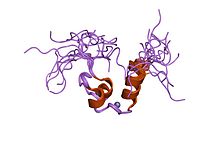
Summary
In molecular biology the DM domain is a protein domain first discovered in the doublesex proteins of Drosophila melanogaster and is also seen in C. elegans and mammalian proteins.[1] In D. melanogaster the doublesex gene controls somatic sexual differentiation by producing alternatively spliced mRNAs encoding related sex-specific polypeptides.[2] These proteins are believed to function as transcription factors on downstream sex-determination genes, especially on neuroblast differentiation and yolk protein genes transcription.[3][4]
| DM domain | |||||||||
|---|---|---|---|---|---|---|---|---|---|
 Drosophila melanogaster doublesex (dsx), nmr, 18 structures | |||||||||
| Identifiers | |||||||||
| Symbol | DM | ||||||||
| Pfam | PF00751 | ||||||||
| InterPro | IPR001275 | ||||||||
| SMART | SM00718 | ||||||||
| SCOP2 | 1rvv / SCOPe / SUPFAM | ||||||||
| |||||||||
The DM domain binds DNA as a dimer, allowing the recognition of pseudopalindromic sequences .[2][5][6] The NMR analysis of the DSX DM domain [6] revealed a novel zinc module containing 'intertwined' CCHC and HCCC zinc-binding sites. The recognition of the DNA requires the carboxy-terminal basic tail which contacts the minor groove of the target sequence.
Proteins with this domain edit
Proteins with the DM domain are found in many model organisms. Many C. elegans Mab proteins contain this domain, the best-known one being mab-3.[1] Human proteins containing this domain include DMRT1, DMRT2, DMRT3, DMRTA1, DMRTA2, DMRTB1, and DMRTC2; each of these have a mouse homolog.[7]
| Dmrt1-specific | |||||||||
|---|---|---|---|---|---|---|---|---|---|
| Identifiers | |||||||||
| Symbol | Dmrt1 | ||||||||
| Pfam | PF12374 | ||||||||
| InterPro | IPR022114 | ||||||||
| |||||||||
DMRT1 homologs have an additional common domain C-terminal to the DM domain. This domain is only found in bony vertebrates, and neither its structure nor function is unknown.[8]: species tree Jpred predicts the human version of the section to be mostly coils; it also suggests a weak similarity to PDB: 6BO4 by BLAST.[9]
| DMRTA motif | |||||||||
|---|---|---|---|---|---|---|---|---|---|
| Identifiers | |||||||||
| Symbol | DMA | ||||||||
| Pfam | PF03474 | ||||||||
| InterPro | IPR005173 | ||||||||
| |||||||||
DMRTA proteins have an additional motif in their C-termina. This motif, ubiquitous in eukaryotes, has an unknown function. It is similar in sequence to some ubiquitin-associated motifs.[10]
References edit
- ^ a b Raymond CS, Shamu CE, Shen MM, Seifert KJ, Hirsch B, Hodgkin J, Zarkower D (February 1998). "Evidence for evolutionary conservation of sex-determining genes". Nature. 391 (6668): 691–5. Bibcode:1998Natur.391..691R. doi:10.1038/35618. PMID 9490411. S2CID 11414843.
- ^ a b Erdman SE, Chen HJ, Burtis KC (December 1996). "Functional and genetic characterization of the oligomerization and DNA binding properties of the Drosophila doublesex proteins". Genetics. 144 (4): 1639–52. doi:10.1093/genetics/144.4.1639. PMC 1207715. PMID 8978051.
- ^ Burtis KC, Coschigano KT, Baker BS, Wensink PC (September 1991). "The doublesex proteins of Drosophila melanogaster bind directly to a sex-specific yolk protein gene enhancer". EMBO J. 10 (9): 2577–82. doi:10.1002/j.1460-2075.1991.tb07798.x. PMC 452955. PMID 1907913.
- ^ Shen MM, Hodgkin J (September 1988). "mab-3, a gene required for sex-specific yolk protein expression and a male-specific lineage in C. elegans". Cell. 54 (7): 1019–31. doi:10.1016/0092-8674(88)90117-1. PMID 3046751. S2CID 1386352.
- ^ Yi W, Zarkower D (February 1999). "Similarity of DNA binding and transcriptional regulation by Caenorhabditis elegans MAB-3 and Drosophila melanogaster DSX suggests conservation of sex determining mechanisms". Development. 126 (5): 873–81. doi:10.1242/dev.126.5.873. PMID 9927589.
- ^ a b Zhu L, Wilken J, Phillips NB, Narendra U, Chan G, Stratton SM, Kent SB, Weiss MA (July 2000). "Sexual dimorphism in diverse metazoans is regulated by a novel class of intertwined zinc fingers". Genes Dev. 14 (14): 1750–64. doi:10.1101/gad.14.14.1750. PMC 316782. PMID 10898790.
- ^ "Proteins matched: DM DNA-binding domain (IPR001275) filtered by species (Homo sapiens)". InterPro.
- ^ "Family: Dmrt1 (PF12374)". Pfam.
- ^ "Jpred results (MTECSGTSQPPPASVPTTAASEGRMVIQDIPAVTSRGHVENTPD)". www.compbio.dundee.ac.uk. Archived from the original on 10 April 2019. Retrieved 10 April 2019.
- ^ "Species: DMRTA motif (IPR005173)". InterPro. Retrieved 10 April 2019.


